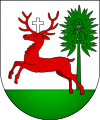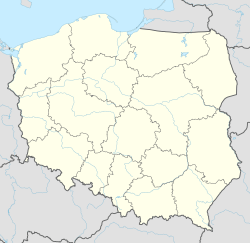Wyrzysk facts for kids
Quick facts for kids
Wyrzysk
|
|||
|---|---|---|---|
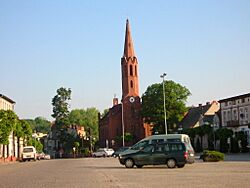
Saint Martin church in Wyrzysk
|
|||
|
|||
| Country | |||
| Voivodeship | Greater Poland | ||
| County | Piła | ||
| Gmina | Wyrzysk | ||
| First mentioned | 1326 | ||
| Town rights | fifteenth century | ||
| Area | |||
| • Total | 4.12 km2 (1.59 sq mi) | ||
| Elevation | 90 m (300 ft) | ||
| Population
(2006)
|
|||
| • Total | 5,234 | ||
| • Density | 1,270.4/km2 (3,290/sq mi) | ||
| Time zone | UTC+1 (CET) | ||
| • Summer (DST) | UTC+2 (CEST) | ||
| Postal code |
89-300
|
||
| Area code(s) | +48 67 | ||
| Car plates | PP | ||
| Website | http://www.wyrzysk.pl | ||
Wyrzysk is a town in Poland. In 2004, about 5,263 people lived there. It is located in Piła County, within the Greater Poland Voivodeship.
Contents
Where is Wyrzysk Located?
Wyrzysk is found in a special area called Krajna, which is in northern Greater Poland. It's officially part of the Greater Poland Voivodeship.
A Look at Wyrzysk's History
The area around Wyrzysk was first settled by people from East Germanic tribes a very long time ago. This was at the start of the first thousand years AD.
Early History and Polish Rule
During the Middle Ages, the Noteć River became a natural border. It separated the regions of Greater Poland and Pomerania. In the 10th century, this area became part of the new Polish state. This was under the Piast dynasty, which was Poland's first ruling family.
For a long time, the region resisted the expansion of German rulers called margraves. From the 13th century, it also resisted the Teutonic Knights, a powerful military order. Over time, local people started calling the area north of the Noteć River "Krajna."
Eventually, a Polish ruler named Bolesław III Wrymouth (who ruled from 1106 to 1138) took control of the castles along the Noteć River. He brought Krajna into the Kingdom of Poland. It remained part of Poland for the next 700 years.
Wyrzysk Becomes a Town
The first time Wyrzysk was mentioned in writing was in 1326. Its name was written down in an old book called the Greater Poland Codex. Wyrzysk likely became a royal town before 1450. By 1565, it officially became a town under a set of laws called the Magdeburg law. At that time, it was part of the Kalisz Voivodeship in the Greater Poland Province.
However, after many wars in the late 17th and early 18th centuries, Wyrzysk became more like a village again.
Prussian Rule and Changes
In 1772, Prussia took over Wyrzysk. This happened during the First Partition of Poland, when parts of Poland were divided among neighboring countries. The town's rights were given back in 1773 by the Prussian King Frederick the Great. He made Wyrzysk an important center for building the Bydgoszcz Canal and managing the Noteć River.
From 1807 to 1815, Wyrzysk was part of the Polish Duchy of Warsaw. This duchy was created by Napoleon. But after Napoleon's defeat, Wyrzysk was given back to Prussia in 1815, following the Congress of Vienna. It stayed under Prussian rule until the end of World War I.
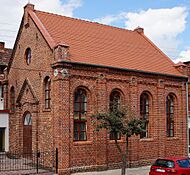
The Prussian rulers wanted to make the Polish lands they took more German. They did this by banning the Polish language, bringing in German administration and education, and encouraging German people to settle there. They also bought land from Polish nobles. In 1773, King Frederick II the Great himself bought Wyrzysk and some nearby areas from Polish owners.
In 1818, Wyrzysk became the main town of a county in the Grand Duchy of Posen. From 1871, it was part of the German Empire. Even though the area became more German over time, Polish people living in Krajna strongly resisted these changes. They held onto their native language and the Roman Catholic religion. This led to the creation of Polish groups like patriotic associations, choirs, sports clubs, and banks to help each other.
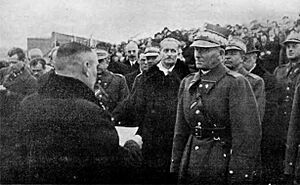
World War II and Modern Times
Wyrzysk became part of a newly independent Poland in 1919, thanks to the Treaty of Versailles. However, just 20 years later, when World War II began, the town was again occupied by Germany. It was then added to a new German province.
In October and November 1939, German police and local German groups arrested many local Poles. They were put in the local prison. Many Poles from Wyrzysk, including teachers and priests, were killed by the Germans in the nearby village of Paterek during this time. From 1940 to 1942, the Germans also forced Poles to leave their homes. These houses were then given to German settlers as part of their plan to expand German territory.
The Germans also ran a forced labor camp in Wyrzysk. It was a subcamp of a larger prisoner-of-war camp. A famous British actor named Sam Kydd was a prisoner there. He wrote in his book that he even learned some Polish phrases from talking to the local people. In 1944, the Germans sent 300 Polish forced laborers, aged 15 to 50, from the county to another forced labor camp.
The Soviet Red Army took the town in January 1945. After the war, Wyrzysk was returned to Poland.
Getting Around Wyrzysk
Wyrzysk used to have a main road, National Road No. 10, that went through it. This road connected Szczecin to Warsaw. But now, a bypass road has been built around the town. This bypass connects Wyrzysk with Piła (about 37 kilometers away) and Bydgoszcz (about 55 kilometers away).
There is also a railway station in the nearby town of Osiek nad Notecią. From there, you can travel by train to Piła (about 39 kilometers) and Bydgoszcz (about 48 kilometers).
Sports in Wyrzysk
The local football (soccer) team is called Łobzonka Wyrzysk. They play in the lower leagues.
Famous People from Wyrzysk
- Rudolf Bauer (artist) (1889–1953), a German-born painter.
- Wernher von Braun (1912–1977), a rocket physicist and engineer who helped develop rockets.



